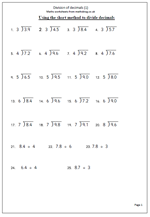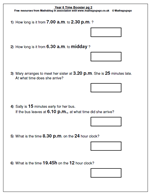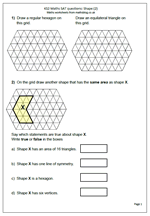This week I would like to look at a page of practice on using the short method of division of decimals. The numbers being divided are just units and tenths which helps with getting the method correct.
There are arguments for and against putting the decimal point in before you start, or leaving it until you have reached that point in the question. it does not matter as long as it is inserted correctly.
One of the best ways to be fluent with this method is to talk it through out loud. If we look at question 2 which is 4.5 divided by 3, the verbal stages are:
a. How many 3s in 4?
b. 1 times 3 is 3 so there is 1 with a remainder of 1.
c. Place the 1 on the answer line, immediately above the 3.
d. Place the decimal point just above the answer line so it can be clearly seen.
e. The remainder 1 is placed just in front of the 5 (usually written smaller).
f. How many 3s in 15?
g. 3 x 5 is 15 so the answer is 5.
h. Place the 5 on the answer line, immediately above the 5 (tenths).
i. Answer 1.5
This page can be found in our Four Rules, Division category.




 Those lovely people who write the SATs really like little mathematical puzzles. One such puzzle is to fill in missing numbers in a square or block. There will always be a logical way to find the answers, usually by completing what is possible will lead to the creation of the next possible step until the whole square can be completed.
Those lovely people who write the SATs really like little mathematical puzzles. One such puzzle is to fill in missing numbers in a square or block. There will always be a logical way to find the answers, usually by completing what is possible will lead to the creation of the next possible step until the whole square can be completed.